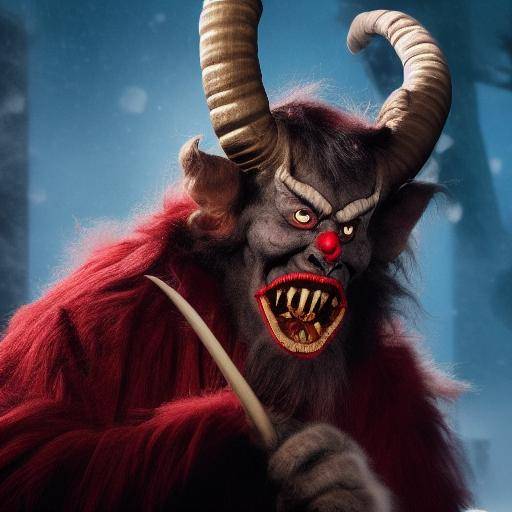
Introduction
Krampus is a legendary figure that forms part of the Austrian folklore, as well as other Alpine regions. This Christmas spirit, though terrifying, plays a unique role in contrast to the affable and generous figure of Santa Claus. In this article, we will explore the origin, meaning and relationship of Krampus with the Christmas tradition in Austria, the punishment of naughty children and their impact on culture.
History and Background
Krampus has its roots in German mythology, where it was considered a pagan figure associated with the winter solstice. His appearance, half goat and half demon, represents the duality of the human spirit: good and evil. This figure is commonly associated with St. Nicholas, who rewards good children, while the Krampus punishes naughty children.
Its presence has been recorded since the seventeenth century, with parties and parades dedicated to its figure in several alpine regions. The popularity of Krampus has been maintained over the centuries, and its influence has transcended the borders of Austria, extending to other European countries.
Analysis in Deep
The role of Krampus in Austrian society has evolved over time. Despite its terrifying appearance, its presence symbolizes community values and the maintenance of social order. This aspect illustrates how folklore and tradition are fundamental elements in the formation of cultural identities.
The figure of the Krampus has also raised debates in contemporary environments, especially with regard to its impact on child psychology. Defenders of this tradition argue that the fear of the punishment of Krampus promotes obedience and respect, while critics question its effect on the emotional well-being of children.
Comprehensive review
Compared to the Austrian tradition with other cultures that celebrate Christmas, the contrast between the generosity of Santa Claus and the punishment of Krampus highlights the diversity of manifestations of the holiday season around the world. This profound analysis reveals the multiple facets of human condition, from goodness and mercy to discipline and self-control.
Comparative analysis
Krampus and its association with the punishment of naughty children present similarities and differences with other legendary figures of Christmas traditions in different cultures. Observing these variations provides an enriching view of how societies interpret and address moral and ethical behaviour, especially in the context of childhood.
Practical Tips and Accessible Recommendations
While Krampus may seem frightening, its presence in the Christmas tradition offers an opportunity to reflect on the meaning of ethical conduct and personal responsibility. In the homes where this figure is celebrated, it is important to balance the teaching of respect and order with the emotional care of children, promoting a healthy balance.
Perceptions of Industry and Expert Reviews
Sociological and anthropological studies on Krampus offer a valuable perspective on cultural practices and intergenerational transmission of values. The opinions of experts in child psychology, anthropology and folklore enrich the understanding of the ramifications of this centenary tradition.
Case Studies and Real Life Applications
The presence of Krampus in contemporary popular culture is reflected in films, books and works of art. These examples provide an enriching picture of how folk traditions adapt and reinvent in the modern era, keeping alive the relevance of legendary figures such as Krampus.
Future Trends and Predictions
As contemporary societies evolve, the interpretation and perception of Krampus and its association with the punishment of naughty children are likely to undergo changes. Emerging trends in conscious upbringing and focus on emotional well-being can influence the reinterpretation or rejection of the Krampus figure in some communities.
Conclusion
In short, Krampus is a peculiar and fascinating figure in the Austrian folklore, which embodies the duality of the human spirit. Its role in Christmas tradition reflects a complex intersection of cultural values, child psychology and the evolution of festive practices. As we reflect on the Krampus, we enter a realm of imagination, morality and deeply rooted traditions.
Frequently asked questions
What's the story behind the Krampus in Austria?
The presence of Krampus in Austria dates back to the seventeenth century, where it was associated with the winter solstice and subsequently integrated into the Christmas tradition.
What is the meaning of Krampus in Austrian culture?
The Krampus symbolizes the duality of the human spirit and plays the role of punishing naughty children, contrasting with the generosity of Santa Claus.
How is the Krampus figure currently celebrated?
Today, the Krampus is celebrated with parades and parties in several Alpine regions, where participants wear elaborate costumes representing the spirit of Krampus.
What is the contemporary view of the Krampus tradition?
The contemporary view on Krampus encompasses a broad spectrum, from the assessment of its role in the preservation of culture to questions about its impact on the emotional well-being of children.
What is the impact of Krampus on child psychology?
The impact of Krampus on child psychology is discussed. While some defend their role in fostering obedience and respect, others question their effect on the emotional well-being of children.
Is Krampus an exclusive Austrian figure?
Although Krampus is prominent in Austria, it is also celebrated in other Alpine regions and has gained relevance in other European countries.
As we explore the figure of Krampus and its connection to the Austrian tradition, the punishment of naughty children and their presence in culture, we enter a world in which the duality of good and evil is intertwined in an ancestral dance, reminding us of the wealth and diversity of Christmas traditions around the world.
